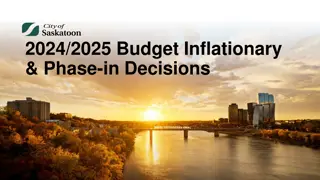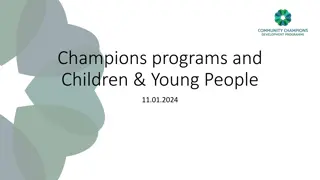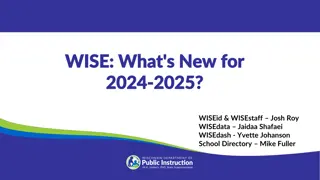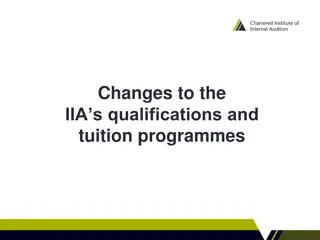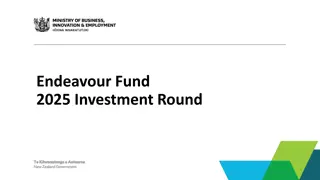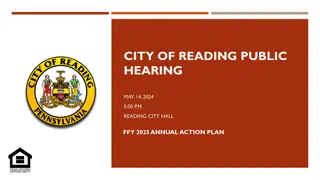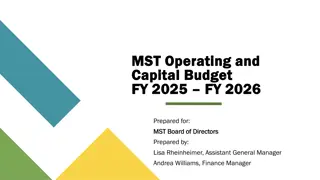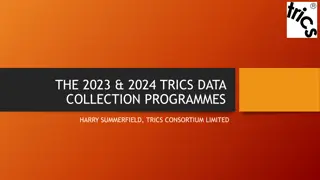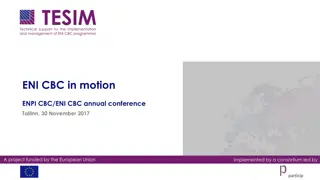Changes and Impacts of Funding Programmes in 2024-2025 for Students
Funding changes for programmes targeting 16-19 year-olds and adult learners were announced for 2024-2025, with increased investment and revised funding formulae. New bands for study programmes and T-level funding were introduced, raising questions about cost implications, programme viability, and support for students with special educational needs.
Download Presentation

Please find below an Image/Link to download the presentation.
The content on the website is provided AS IS for your information and personal use only. It may not be sold, licensed, or shared on other websites without obtaining consent from the author.If you encounter any issues during the download, it is possible that the publisher has removed the file from their server.
You are allowed to download the files provided on this website for personal or commercial use, subject to the condition that they are used lawfully. All files are the property of their respective owners.
The content on the website is provided AS IS for your information and personal use only. It may not be sold, licensed, or shared on other websites without obtaining consent from the author.
E N D
Presentation Transcript
How your programmes will be funded in 2024 to 2025 Changes to the funding of programmes for 16-19 year old students pay awards announced in Summer 2023 Proposed changes to the funding of programmes for adult learners changes to earnings in non-devolved areas and to adult skills funding rates Good news at last but ..
Pay awards for 2023 to 2024 and 2024 to 2025 Sec of State announced that 185m would be made available to address key priorities and cover the cost of increased pay awards for the period August 2023 to March 2024, and 285m for the period April 2024 to March 2025 Routed through 16-19 funding formula PCWs for higher-cost subjects Increasing the per-student funding rate, including T levels Also increased block 2 disadvantage uplift to 559 per student Allocations were revised over the summer of the 2023 to 2024 academic year Updated payments started in Autumn just over 4.6% increase since 2022 What about colleges who have lower proportions of 16-19 students, and higher proportions of adult learners?
New study programme bands 2023 to 2024 Band Annual planned hours Category Funding Rate per student 5 580 plus 16 and 17 year-old students Students aged 18 and over with high needs Students aged 18 and over who are not high needs 16 and 17 year olds and students aged 18 and over with high needs 4753 4a 485 plus 3932 4b 485-579 3 2 385-484 300-384 All students All students 3198 2528 1 Up to 299 hours All students 4753 proportion of band 5
New T level funding bands 2023 to 2024 Band Minimum planned hours for the band 2 years Average planned hours 2 years Funding Rate 2 years 6 1180 1330 10,876 e.g. early years 7 1380 1530 12,544 e.g. surveying 8 1580 1680 13,794 e.g. electrical 9 1730 1830 15,046
Key questions? How well do the increases in rates of funding reflect increases in the real costs of delivery? What are the impacts in real terms? What about the viability of different programmes? How will the increase in band hours affect different programmes and students ? Will the increased levels of funding for high cost and high value programmes have unforeseen consequences, e.g. for breadth of programmes offered or for student choice? Will T Level programmes be viable in terms of class size and reasonable contribution rates? What about the future of other level 3 programmes? With the emphasis on level 3, what will be the impacts on programmes at Level 2, which for some providers is their largest cohort of learners? How well will the needs of students with SEND be met with the changes? What will be the impacts of longer programmes on student support budgets? How will we grow the number of high quality placements in the competing world for industry placements?
Changes to AEB earnings in non-devolved areas Will apply to providers funded by ESFA outside of the GLA and CMAs for academic years 2022 to 2023 and 2023 to 2024 some devolved authorities have already increased AEB earnings for providers 2.2% increase in final earnings for AEB formula funded provision, excluding associated learning and learner support funding 20% boost to earnings for all AEB formula funded provision in 6 SSAs engineering, manufacturing technologies, transport operations, building and construction, ICT for practitioners, maths and statistics Applied to both grant and contract funded provision Applied at end of each academic year, not in monthly earnings Raise the AEB over-delivery threshold to 110% (as in previous year) on a permanent basis going forward to give providers confidence to increase volume of education and training and to invest in high value skill provision
Proposed changes to funding of adult skills Originally intended to introduce changes in 2023 to 2024 Multi-year budgets Single skills budget combining AEB (including ACL) and FCFJ New simpler accountability agreements for colleges Simplified funding bands Increasing funding rates for skills priority courses New vision for non-qualification provision Lagged funding Skills bootcamps and adult training from the UK Shared Prosperity Fund would remain separate Reduce inconsistencies and variations resulting from devolution of AEB Most changes put back by a year after consultation with the sector
Adult skills funding rates for 2024 to 2025 Covers what was the AEB and Free Courses for Jobs offer, now merged into the Skills Fund Methodology = hourly rate x GLH GLH assigned by the awarding organisation and recorded on Ofqual s register of regulated qualifications All qualifications are moving to a standard GLH including those on QCF (based on credits and not GLH) Expectation is that 78% of qualification rates will increase, 20% fall and 2% stay the same Need to compare rates on the Single Activity Matrix for 2023 to 2024 with the rates on the new tables The policy exceptions such as GCSEs and A levels remain unchanged, except for Access to HE Diplomas which are assumed to have 600 GLH Functional skills stay the same, except for digital skills which are increased from 336 to 462 (55 GLH @ 8.40)
Single Activity Matrix for 2023 to 2024 funding year Certain qualifications have their funding band set as a matter of policy
Proposed new funding rates applied to adult skills Base Low Medium High Specialist New bands New hourly skills funding rate 6.00 7.20 8.40 9.60 12.00 Digital skills will be Medium at 8.40 per GLH. e.g. Funding for 50 glh qualification @ 8.40 = 420.
Weighted rate/hr Weighted rate/hr Difference Qualification GLH SAM New rate Digital functional skills 55 336 5.64 462 8.40 126 EDSQ entry 3 50 300 6.00 420 8.40 120 Access to HE Computing 600 3,928 6.55 5.040 8.40 1,112 Level 2 award in digital and IT skills 240 1,645 6.85 2,016 8.40 371 Level 2 award in progression 60 450 7.50 360 6.00 -90 What could be the impacts on your adult skills offer?
Good news for adults but . Will the increases in funding rates mean that we are keeping up with inflation? What about the qualifications that have reduced funding? What will happen to the scope of our offer? Will there be more money in the total skills fund than previously in the AEB and FCfJ pots? What will be the impact of Local Skills Improvement Plans? What about the Lifetime Learning Entitlement and adults funding their learning with loans? Lessons learned from Advanced Learner Loans?











